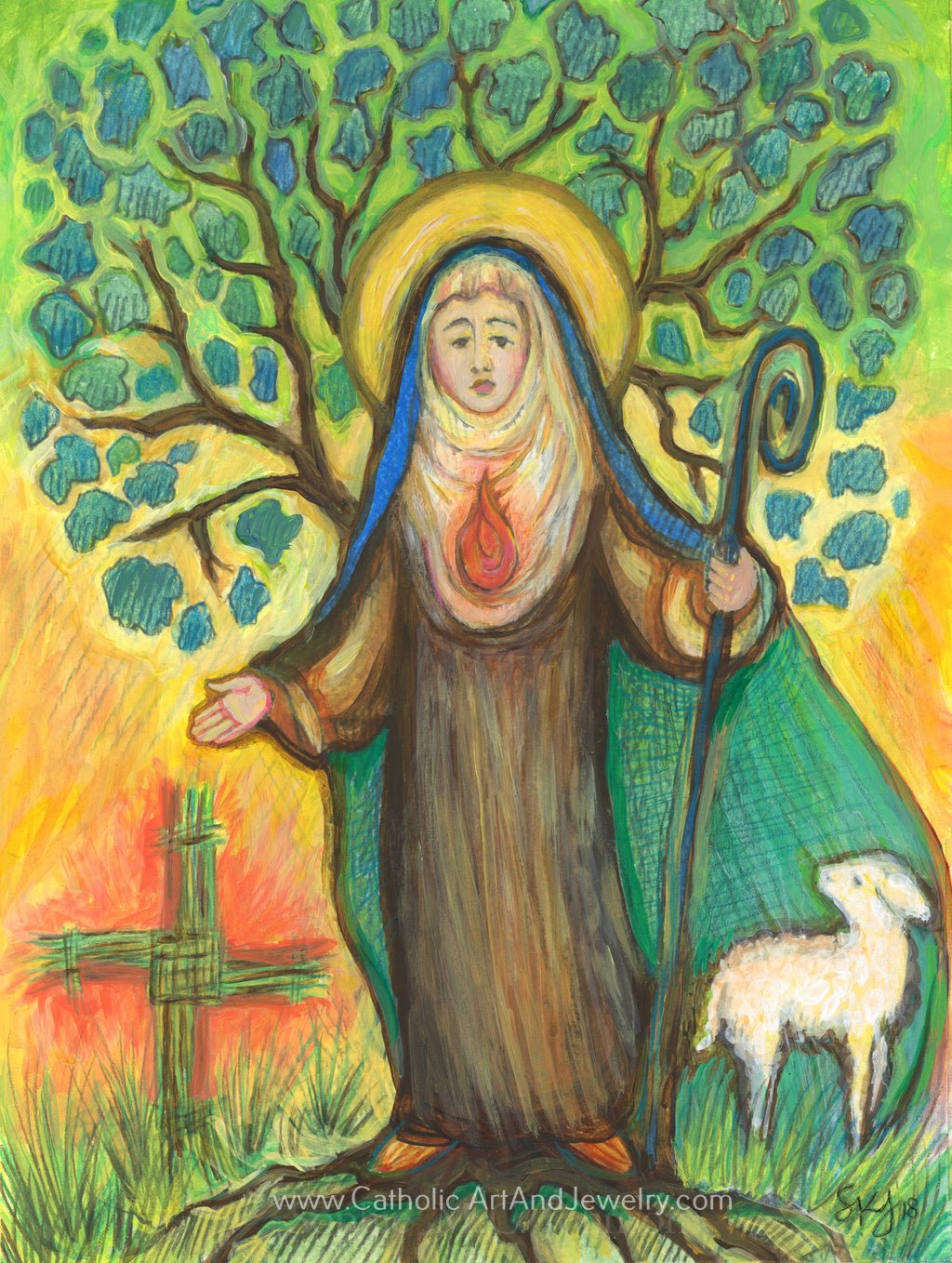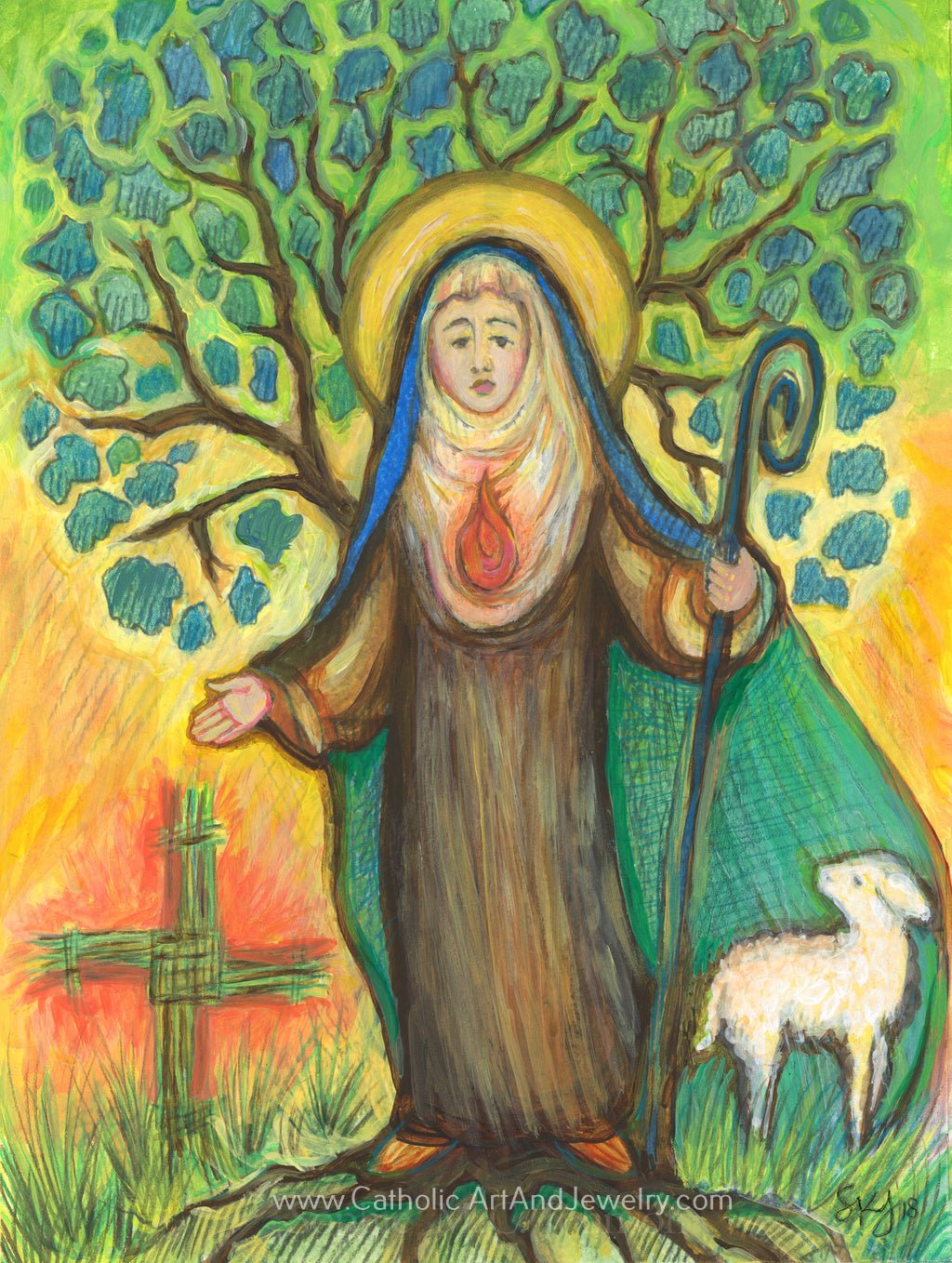Sue Kouma Johnson
Brigid of Ireland Print
Brigid of Ireland Print
Couldn't load pickup availability
Vivid colors and dynamic composition make this print a lively addition to your home. Saint Brigid is a long beloved patron of Ireland, milkmaids, newborn babes, and crafters! The original was painted in colored pencil and acrylic paint on paper by Sue Kouma Johnson.
Saint Brigid was born Brigit, and shares a name with a Celtic goddess from whom many legends and folk customs are associated.
It is widely believed that Brigid's mother was Brocca, a Christian baptized by Saint Patrick, and her father was Dubthach, a Leinster chieftain. Brocca was a slave, therefore Brigid was born into slavery.
When Dubthach's wife discovered Brocca was pregnant, she was sold to a Druid landowner. It is not clear if Brocca was unable to produce milk or was not present to care for Brigid, but legend states Brigid vomited any food the druid attempted to feed her, as he was impure, so a white cow with red ears sustained her instead.
Many stories of Brigid's purity followed her childhood. She was unable to keep from feeding the poor and healing them.
When Brigid was 10, she was returned to her father's home, as he was her legal master. Even there, she was always generous to the poor.
Eventually, her father tired of her charitable nature and took her to the king of Leinster, hoping to sell her. As he spoke to the king, Brigid gave his jeweled sword to a beggar so he could barter it for food for his family. When the king, who was a Christian, saw this, he recognized her heart and convinced Dubthach to grant her freedom by saying, "Her merit before God is greater than ours."
After being freed, Brigid returned to the Druid and her mother, who was in charge of the Druid's dairy. Brigid took over and often gave away milk, but the dairy prospered despite the charitable practice, and the Druid eventually freed Brocca.
Brigid then returned to her father, who had arranged for her to marry. She refused and made a vow to always be chaste.
It is said that when Saint Patrick heard her final vows, he accidentally used the form for ordaining priests. When someone pointed out his mistake, he replied, "So be it, my son, she is destined for great things." Thus, she is shown with the Shepherd's Crook of a bishop.
Little is known about Saint Brigid's life after she entered religion. We do know she founded a monastery in Kildare. It was built above a pagan shrine to the Celtic goddess Brigid, which was beneath a large oak tree. Triumph of the Church over paganism!
Brigid and seven friends organized communal consecrated religious life for women in Ireland and she founded two monastic institutions, one for men and one for women. Brigid invited a hermit called Conleth to help her in Kildare as a spiritual pastor.
Her biographer reported that Brigid chose Saint Conleth "to govern the church along with herself."
She later founded a school of art that included metalwork and illumination, which Conleth led as well. It was at this school that the Book of Kildare, which the Gerald of Wales praised as "the work of angelic, and not human skill," was beautifully illuminated, but was lost three centuries ago.
The cross in the picture represents a practice Brigid had of weaving crosses out of reeds, and teaching children how to do it.
The Trias Thaumaturga claims, "Between St. Patrick and Brigid, the pillars of the Irish people, there was so great a friendship of charity that they had but one heart and one mind. Through him and through her Christ performed many great works."
On February 1 525, she passed away of natural causes. Her body was initially kept to the right of the high altar of Kildare Cathedral, with a tomb "adorned with gems and precious stones and crowns of gold and silver," but in 878, during the Scandinavian raids, her relics were moved to the tomb of Patrick and Columba.
Her feast day is celebrated on February 1st,and she is the patron saint of Ireland, dairymaids, cattle, midwives, Irish nuns, and newborn babies. (from Catholic Online)
-------------------
IMPORTANT: Each of the 3 sizes indicates outside dimensions. There is a border of white left around the image, approximately 1 1/2" to 2" all around.
Signed by artist.
Archival Quality
Comes in a close-fitting crystal-clear plastic sleeve with a whiteboard backing.
Archival Quality: All our prints are made using premium acid-free fine art paper in card thickness, and high quality Epson pigments (instead of dyes), rated by a third party to last 200+ years when not hung in direct sunlight. These prints are beautiful today and are time capsules of the faith for future generations.
(C) Copyright Sue Kouma Johnson
This image may not be reproduced in any form without the artist's expressed permission.


